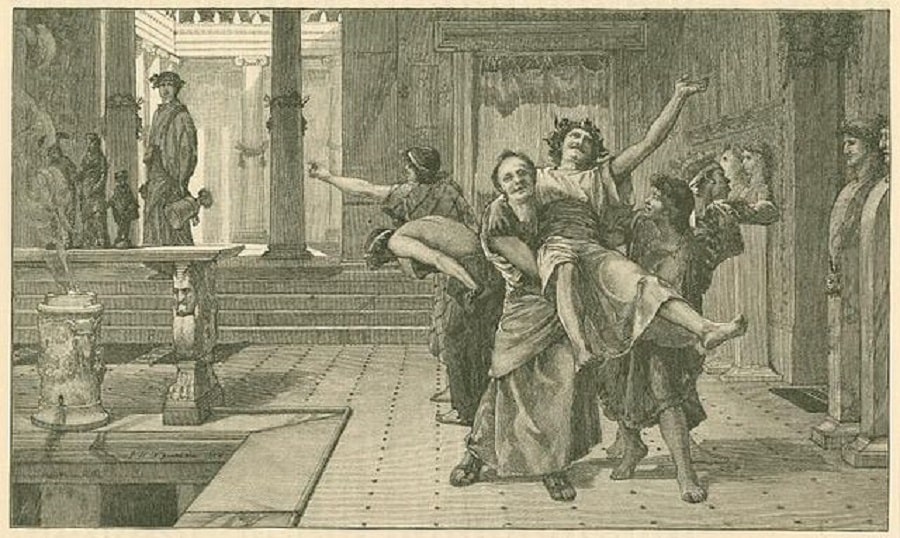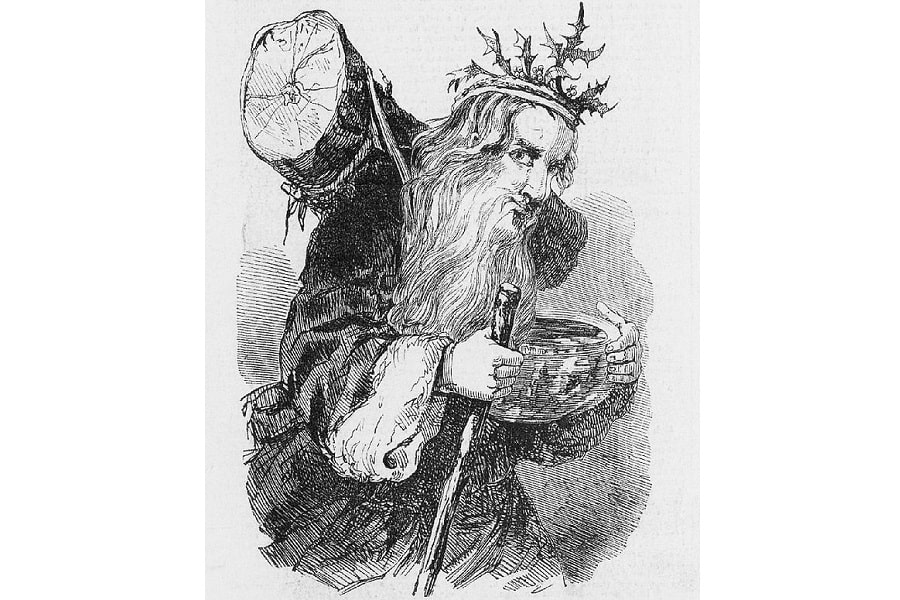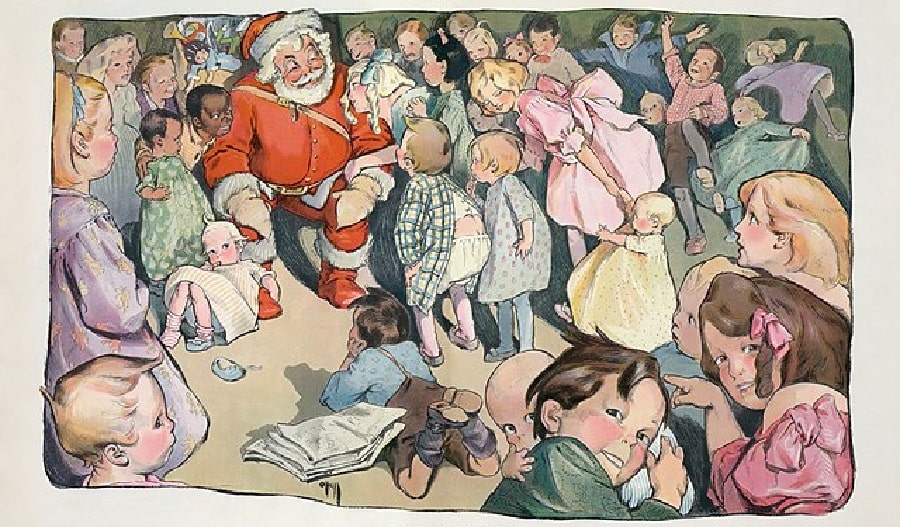The origins of Christmas can be traced back to the ancient Roman and Norse civilizations. In fact, 25th December was not even Jesus’ date of birth. The early Christians appropriated what was originally a pagan holiday because it was convenient. Before that, the people of ancient Europe had celebrations of the pagan god Saturn or even Odin at the end of December to mark the shortest day of the year. Indeed, many of the Christmas traditions we have today come from these ancient festivals. Examples of this include kissing under the mistletoe and decorating trees.
Table of Contents
What are the Pagan Origins of Christmas?

The origins of Christmas are complex and intertwined with various cultural and religious traditions, including some pagan elements. While Christmas is primarily celebrated as a Christian holiday commemorating the birth of Jesus Christ, it coincides with the winter solstice and incorporates elements from pre-Christian traditions.
The winter solstice (for the northern hemisphere) takes place on 22nd December, the day when the Earth’s axis is tilted furthest away from the sun. It is the shortest day of the year and is meant to mark the beginning of winter in the northern hemisphere. But it is also a time of hope because the days begin lengthening again as spring is coming.
Ancient civilizations around the world thought this was worthy of great celebration. When the early Christians linked these winter solstice celebrations with Christmas, it simply made the birth of Jesus that much more auspicious.
A lot of people in the modern world may not even know that this winter celebration actually has nothing to do with the scriptures and religion. They may be even more surprised to learn that Christmas celebrations like decorating with holly, putting up Christmas trees, and kissing under the mistletoe are rooted in ancient fertility rituals. These are all symbolic acts to celebrate the fertility of the earth and the approach of the sowing season.
Who Were the Pagans?

Before throwing the word ‘pagan’ around, we should first discuss what it means. Who were the pagans exactly? ‘Paganism’ was originally a word used by the early Christians to refer to the polytheistic Romans. What it essentially means is ‘non-Christian’. It could apply just as well to the Norse people in Scandinavia or the ancient Celts in the British Isles. As the Christian missionaries began to roam around Western Europe (and the larger world), they used the term ‘pagan’ to refer to anyone who did not share their beliefs on religion. Their multiple gods were classed within the single category of ‘pagan gods’.
In the first few centuries of Christianity, the Christians wanted to spread their religion around Europe. But they were also quite fascinated by the religions that already existed. They knew that it would be difficult for ordinary people to completely divorce themselves from everything they had always known. This included the celebrations for the winter solstice. They had to give the people something that was familiar and known. Given that Jesus was born around the same time, it was easy enough to incorporate existing traditions into the celebration of the birth of Jesus.
READ MORE: How Did Christianity Spread: Origins, Expansion, and Impact
The Romans and the Saturnalia Festival

The people of ancient Rome celebrated the winter solstice with the festival of Saturnalia. It was meant as a way to celebrate and give thanks to the Roman god of agriculture, Saturn. By the time the winter solstice came out, the last planting season had been completed. Thus, the ancient Romans could then happily engage in an entire week of festivities. The Saturnalia festival was usually celebrated between 17th December and 24th December. Even now, Christmas is not really a celebration of one day. It is called the Christmas season and festivities start well in advance of 25th December. In the Saturnalia festival, 25th December was considered the climax and had a special name – Brumalia.
During Saturnalia and Brumalia, all social hierarchies were overturned. The people, including the Roman slaves, indulged in widespread merrymaking. The slaves could even take part in public celebrations and not work on the last day of the festival. Public gambling was a big event and everyone was allowed to wear colorful clothes. The Phrygian cap – worn by the freed Roman slaves – was worn as a symbol of the freedom of the season. Many of the modern Christmas traditions originated in the ancient Roman Empire.
However, there might have been a darker side to the Saturnalia festival. An innocent Roman citizen would be elected as the Lord of Misrule for a period of 30 days for the festival. This was a temporary king of sorts who would preside over the wild partying and drunken antics during the celebration. On the last day, this Lord of Misrule would be sacrificed to Saturn on the altar. This marked the end of anarchy and a return to social conventions. There is no conclusive evidence for this, although folklorists like James Frazer and Mikhail Bakhtin have theorized about it.
The Romans had another festival around the same time – Dies Natalis Solis Invicti (birth of the invincible sun). This was dedicated to the Iranian sun god, Mithra. In pre-Zoroastrian Iran, Mithra was the god of the sun, justice, and war. He was heavily associated with the Roman sun god Sol. Emperor Aurelian declared that 25th December was the birthday of the ‘Unconquerable Sun’ and it was a festival mostly celebrated by upper-class male Romans. In fact, Mithraism was a special and select cult. It is interesting that Christians decided to celebrate the birth of Jesus on this very day. What is also interesting is that one of the epithets of Jesus is the ‘sun of justice.’
READ MORE: Roman Gods and Goddesses: The Names and Stories of 29 Ancient Roman Gods
What Was Yule?

Other than Saturnalia, one of the festivals that had a huge influence on Christmas was Yule. Celebrated largely by the Norse people in northern Europe, many of the old Yule traditions have become Christmas traditions today. The celebrations lasted for 12 days and huge bonfires were lit. Feasting and drinking were a big part of the celebrations. The night before Yule was called Mother’s Night. The Yule tree was decorated around the time of the winter solstice and the Yule log would be lit so that families could feast and be merry by the fire all night. The Yule ham was a huge aspect of this celebration since the boar was sacred to the pagan god Freyr. The Christians have appropriated many of these traditions to celebrate Christmas.
Another important pagan holiday during the winter solstice was the birthday of the Greek god Dionysus. The Greek god of wine was celebrated with wild revelry, feasts, drunkenness, and merrymaking over 12 days. His birthday was supposed to be on 25th December. The festival was called Bacchanalia and was one marked by wildness and excess. In Finland, the sun goddess Beiwe was celebrated during this time. She was said to ride on a sleigh made of reindeer bones and pulled by a white reindeer. Perhaps she was a precursor to Santa Claus?
READ MORE: 41 Greek Gods and Goddesses: Family Tree and Fun Facts
The Slavic people too had their own winter solstice festivals. Karachun is a pagan holiday that is celebrated in honor of the black god Chernoborg. Very similar to Samhain and Halloween, this was the day when all Slavic gods associated with darkness and decay were most potent. However, the white god or the sun god is resurrected the next day and triumphs again. Ancient Slavs lit fires in cemeteries and crossroads on this day to keep their loved ones warm. Feasts were organized to honor the dead and feed them. These practices have merged with modern Christmas traditions.
Celebrating the Winter Solstice
Many of the Christmas traditions that we celebrate today are descended from pagan traditions. This includes the practice of exchanging gifts, decorating houses and trees, door-to-door carollers, the use of holly and mistletoe, and even the kind of food that is usually prepared. For instance, the Yule Log – a cake commonly eaten in Western Europe – is more symbolic than anything now, meant to invoke the bonfires of ages past.
What Does the Christmas Tree Symbolize?

A huge part of a modern Christmas is decorating Christmas trees. Modern Christmas trees probably originated in Germany, during the Renaissance. The lighting of candles on evergreen trees in order to celebrate Christmas is sometimes traced back to the Protestant reformer Martin Luther. However, the Christmas tree has much more ancient predecessors.
The Romans used to hang small metal ornaments on trees outside their home during Saturnalia. Each ornament had some kind of association with a god or even the family’s patron saint. The Roman poet Catallus, in his poem Marriage of Peleus and Thetis, spoke of the gods decorating the home of Peleus with evergreen trees like laurel and cypress. Evergreen trees and wreaths and garlands made of them were significant to the Egyptians, Hebrews, and Chinese. They represented eternal life.
For the early Germanic tribes, decorating trees with fruits and candles in honor of Odin was a common practice. Trees were very important in Norse mythology because of Yggdrasil. The Vikings and Saxons worshiped trees. Early Germanic folktales about Saint Boniface and Donar’s Oak talk of how an evergreen tree grew in the place of the felled oak. The triangular shape was supposed to be reminiscent of the Trinity and an indication to look toward heaven. Thus, we can conclude that the Christmas tradition of setting up a tree is rooted in ancient pagan beliefs.
Gift Giving and Carolling

Gift-giving is a common practice during most festivals. These are occasions where we can show our affection for our loved ones in the form of material presents. Leaving Christmas gifts under the Christmas tree might be a very modern practice but the very act of giving gifts to your family is as old as humans themselves.
READ MORE: How Long Have Humans Existed?
The Romans gave each other small gifts during Saturnalia in the hope of a bountiful harvest the next day. It was a way of wishing each other good luck.
Even Christmas carols have ancient roots. The Christmas carols in themselves and their lyrics might be more modern, but the tradition is probably Anglo-Saxon. The Anglo-Saxon tradition of going door to door and singing to your neighbors was called wassailing. It came from the phrase ‘waes hael’ meaning ‘good health.’ Every year, these singers would roam around the village in small groups, serenading their neighbors and wishing away evil spirits and bad health.
Wassailers usually carried a traditional drink with them, made from mulled ale, roasted apples, spices, eggs, sugar, and curdled cream. Sounds like a very Christmassy drink, does it not? St. Francis, in the 13th century, took inspiration from the wassailers and began the Christmas tradition of door-to-door carollers.
The Significance of Holly and Mistletoe

Holly and mistletoe were both sacred plants for the pagans. Kissing under the mistletoe and decorating homes with holly were originally pagan traditions. Now, they have become such an intrinsic part of Christmas that it would be difficult to imagine the holiday without them.
During Saturnalia, the Romans would exchange wreaths made of holly for good luck. Holly was a holy plant that was associated with Saturn, the god of agriculture. The early Christians were lucky that the festival of Saturnalia almost coincided with Jesus’ birth. Since they were often heavily persecuted, Saturnalia gave them a cover to celebrate their own festival without being discovered. Thus, they began to take on this pagan custom and decorated their homes with holly to make it look like they were celebrating Christmas. This made it easier for them to recognize each other in the midst of other communities. They continued the practice even after paganism disappeared from Europe.
Kissing under mistletoe, one of the most popular Christmas traditions also has pagan roots. The ancient Norse, Celts and their Druids were all obsessed with mistletoe to a certain extent. Also, the plant was considered sacred to Saturn and the ancient Romans would perform fertility rituals under it. In other words, they had sex under mistletoe plants for the sake of a bountiful harvest. A kiss is certainly a step down from that!
For the Druids, mistletoe stood for peace and joy. When two enemies met under a sprig of mistletoe, they were required to drop their weapons and form a truce till the next day. Kissing under the mistletoe is a metaphorical truce of sorts. The plant was supposed to protect one from evil spirits and have magical powers.
Is Santa Claus a Pagan Concept?

Modern Christmas celebrations are incomplete without Santa Claus. ‘Santa Claus’ is a bastardized version of the name ‘Saint Nicholas.’ The image that we are familiar with today was developed, shockingly enough, by Coca-Cola in the 1930s.
St. Nicholas, also known as Santa Claus or Father Christmas, was the patron saint of children, prostitutes, and the poor. He lived during the 4th century and was well-known for giving small gifts to children and the poor. A generous bishop, he had a long beard and wore a large cloak.
However, the origins of a Santa-like figure are much older. Odin, the much-loved king of the Norse gods, was a bearded old man who was believed to leave gifts for children. He is usually depicted as an old man with a long white beard. He also had an eight-legged horse called Sleipnir. Odin would ride Sleipnir across the sky just as Santa does with his reindeer. Young children would fill their booties with straw and carrots during the winter and leave them by the door for Sleipnir to feed on. They would be rewarded with little gifts in their booties. This was the true beginning of Santa Claus and the stockings that we leave out on Christmas Eve.
Was Christmas Stolen from the Pagans? Christianity Appropriates the Winter Solstice
Thus, as we can see, the ancient Christians incorporated several pagan traditions while celebrating Christmas. Perhaps at the time they did it from a sense of safety. Perhaps it was because they genuinely enjoyed those customs. Looking at these Christmas traditions and customs, it becomes even more evident that the early Christians were not really converts from Judaism. Jesus may have been a Jew but most of his followers were those on the outskirts and fringes of society. And they incorporated the customs they were used to into the festival.
Long before Jesus’ birth, the middle of winter was celebrated by people all over the world. It was a victory of light over dark. It was an affirmation of hope. It was a celebration of fertility and bounty in the coldest and darkest of times. Thus, feasting, bonfires, and fertility rituals were so important during the winter solstice festivals. The coming of a messiah was simply another occasion to celebrate this time of the year.
Was Jesus Really Born on Christmas?

The simple answer is no. Jesus was probably not born on 25th December. Easter was actually the main holiday of the early Christians. In the first few centuries of Christianity, Jesus’ birth was not celebrated in the big way that it is now. The Bible does not even mention a specific date for the birth. Indeed, it was only in the 4th century CE that Pope Julius I declared the 25th of December as the official birthday of Jesus of Nazareth.
Not only is the day of Jesus’ birth not known, historians cannot even pin down his year of birth. It was most probably between 6 BCE and 4 BCE, the year in which King Herod died. Some scholars have challenged the winter birth in the first place, arguing that shepherds would not have been grazing their flocks in winter. Actual research shows that it is more likely Jesus was born in mid-April.
Thus, 25th December is only a symbolic date, chosen for completely different reasons. It is commonly accepted that the Christian Church chose the date to absorb the traditions of the Saturnalia festival. It was originally called the Feast of the Nativity. By the 6th century, the custom had spread to England, where it began to absorb the more Germanic aspects of the celebration.
When Was Christmas First Celebrated?
The Church decided to celebrate Christmas at the same time as the winter solstice to increase the chances of it being embraced by the masses. But this meant that they had to give up control over how it would be celebrated. It seems that they were successful since Christianity had almost completely replaced the pagan religions by the Middle Ages.
The first celebrations of Christmas started in the 4th century CE after an official date was declared. Believers attended church, exchanged Christmas gifts, and celebrated in a rather drunken, carnival-like atmosphere. It was certainly not a sedate or dignified kind of festival and people of all social classes came together to celebrate.
It was only in the 17th century, with the wave of Puritan religious reforms, that this kind of Christmas celebration changed. In England, Oliver Cromwell and his government canceled Christmas in 1645 to remove decadence. The festival was reinstated by Charles II when he took the throne but the Puritans always looked down on the holiday. This was especially true of the Orthodox pilgrims who emigrated to the United States in the early 17th century. Only in the 19th century did the Americans begin to embrace Christmas and it did not become a federal holiday in America until 1870.
Cancel that